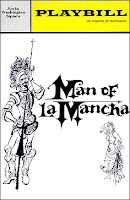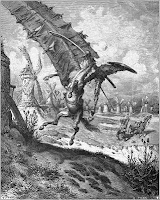Alonso goes so far as to set out on a quest, under the rather marvelous name of Don Quixote de la Mancha. (Marketing is everything.) Every knight needs a squire, and Quixote recruits an affable farmer, Sancho Panza, to ride with him to doom or glory--and doom seems the more likely of the two.
Along the way, this knight wages war on fierce giants (who are actually windmills) and fights to defend the virtue of his beloved Lady Dulcinea (who is actually Aldonza, a woman of ill repute). But who has the clearer vision--Quixote's family, who perform cruel acts to try to "save" him, or Quixote himself, who works hard to see the best in everybody?
 |
| Title page, Fourth edition |
The two books about Don Quixote's adventures were written by Miguel de Cervantes in early 17th century Spain, and they are considered to be among the greatest literary works of all time. The story has been retold in many forms, but my favorite is the 1964 musical, Man of La Mancha (Music: Mitch Leigh; Lyrics: Joe Darion; Book: Dale Wasserman).
 The musical has so many great moments. I love it when Quixote dons a barber's basin and calls it the Golden Helmet of Mambrino. I love it when his family sings "I'm Only Thinking of Him," when it's so obvious they are thinking only of themselves. And I love it when Quixote keeps a sacred vigil before his "knighting" and sings "To Dream the Impossible Dream."
The musical has so many great moments. I love it when Quixote dons a barber's basin and calls it the Golden Helmet of Mambrino. I love it when his family sings "I'm Only Thinking of Him," when it's so obvious they are thinking only of themselves. And I love it when Quixote keeps a sacred vigil before his "knighting" and sings "To Dream the Impossible Dream."But my favorite moment comes near the end, when sadly, Quixote dies. Someone addresses Aldonza by her name, and she corrects him. "My name," she says, "is Dulcinea." It turns out that Quixote's strange vision has worked a transformation in this woman, in the way she now sees herself. Quixote's failed quest is a success after all.
Happy birthday to Miguel de Cervantes, born September 29, 1547. I'm grateful for the story he gave us--and for all the Quixotes who see the world differently from "normal" folk, who challenge our definitions of truth and reality, who still dare to dream the impossible dream.
Ever feel like you're tilting at windmills? Don't give up. You never know whose life is changing because of what you see when you look at them.
Stark Raving Mythopath highly recommends the original Broadway cast recording of Man of La Mancha. I'm not sure if this recording is from that edition, but it's good. Enjoy: The Impossible Dream.




































